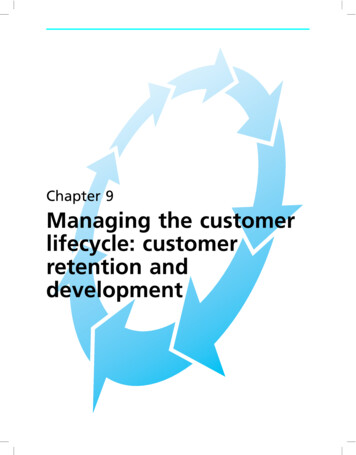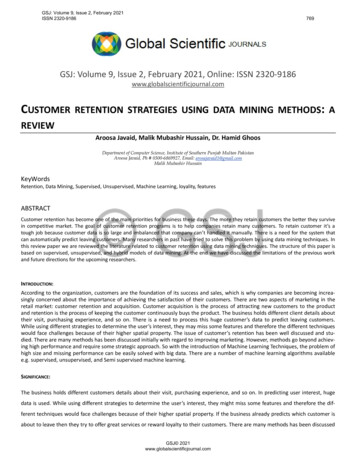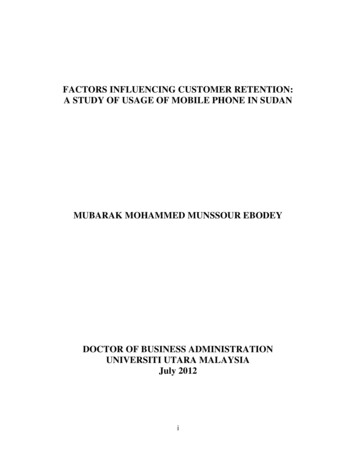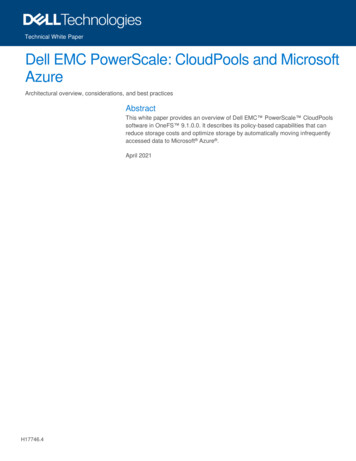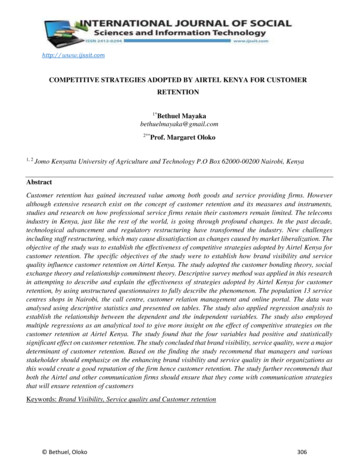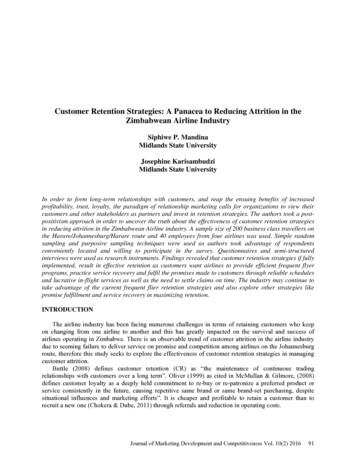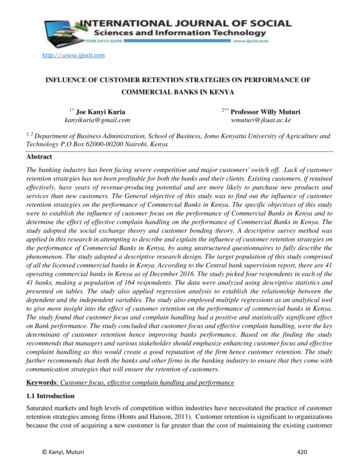
Transcription
http://www.ijssit.comINFLUENCE OF CUSTOMER RETENTION STRATEGIES ON PERFORMANCE OFCOMMERCIAL BANKS IN KENYA1*Joe Kanyi Kuriakanyikuria@gmail.com2**Professor Willy Muturiwmuturi@jkuat.ac.ke1, 2Department of Business Administration, School of Business, Jomo Kenyatta University of Agriculture andTechnology P.O Box 62000-00200 Nairobi, KenyaAbstractThe banking industry has been facing severe competition and major customers' switch off. Lack of customerretention strategies has not been profitable for both the banks and their clients. Existing customers, if retainedeffectively, have years of revenue-producing potential and are more likely to purchase new products andservices than new customers. The General objective of this study was to find out the influence of customerretention strategies on the performance of Commercial Banks in Kenya. The specific objectives of this studywere to establish the influence of customer focus on the performance of Commercial Banks in Kenya and todetermine the effect of effective complain handling on the performance of Commercial Banks in Kenya. Thestudy adopted the social exchange theory and customer bonding theory. A descriptive survey method wasapplied in this research in attempting to describe and explain the influence of customer retention strategies onthe performance of Commercial Banks in Kenya, by using unstructured questionnaires to fully describe thephenomenon. The study adopted a descriptive research design. The target population of this study comprisedof all the licensed commercial banks in Kenya. According to the Central bank supervision report, there are 41operating commercial banks in Kenya as of December 2016. The study picked four respondents in each of the41 banks, making a population of 164 respondents. The data were analyzed using descriptive statistics andpresented on tables. The study also applied regression analysis to establish the relationship between thedependent and the independent variables. The study also employed multiple regressions as an analytical toolto give more insight into the effect of customer retention on the performance of commercial banks in Kenya.The study found that customer focus and complain handling had a positive and statistically significant effecton Bank performance. The study concluded that customer focus and effective complain handling, were the keydeterminant of customer retention hence improving banks performance. Based on the finding the studyrecommends that managers and various stakeholder should emphasize enhancing customer focus and effectivecomplaint handling as this would create a good reputation of the firm hence customer retention. The studyfurther recommends that both the banks and other firms in the banking industry to ensure that they come withcommunication strategies that will ensure the retention of customers.Keywords: Customer focus, effective complain handling and performance1.1 IntroductionSaturated markets and high levels of competition within industries have necessitated the practice of customerretention strategies among firms (Honts and Hanson, 2011). Customer retention is significant to organizationsbecause the cost of acquiring a new customer is far greater than the cost of maintaining the existing customer Kanyi, Muturi420
International Journal of Social Sciences and Information TechnologyISSN 2412-0294Vol IV Issue X, October 2018(Ro-King, 2005). According to Kotler (2006), acquiring new customers can cost five times more than the costsinvolved in satisfying and retaining the current customers and that the customer profit rate tends to grow overthe life of the retained customer.The advocates of customer retention argue that retaining customers improve profitability, mainly by reducingthe costs sustained in acquiring new customers (Reichheld, 1996). Customer retention enables the organizationto withstand the intense competition besides appreciating significant savings from retaining existing customers.According to Stengel (2003), organizations can increase profits by 25 to 95 percent with a mere increase of 5percent in customer retention rates. A small increase in customer retention rate will further accelerateorganization’s profits (Ryals and Knox, 2005).According to Reichheld and Schefter (2000), the strategies pursued that help retain customers include loyalty,change of channels of distribution creative filtering of quality customers, rewarding the sales force, paying forcontinuity, and designing special programs that attract and hold the most valuable customers. Customerretention entails providing a differentiated attention. Lions (2010) states that customer service is one of theundisputable ways of retaining customers. It means that your customers feel that you understand them and theirneeds outstanding service is what customers require and if this is offered then the customers feel worth of therelationship. A successful organization is defined by the relationship it has with its customers (Jill &Lowenstein, 2007).Mermann (2007), argues that when an organization differentiates its products it will make its competitorirrelevant and guarantee sales which ensure its survival. Services can be differentiated through speed,performance, quality, responsiveness, and availability. Neil (2008), states that strong brands have thecapability to attract and retain customers. Thus, organizations should endeavor to have strong brands so as toenhance their branding in order to build product recognition and loyalty that further enhances customer value.Customer retention involves a series of strategies that must be taken in order to attract and retain customers byensuring that service providers deliver the expected service first. Customer retention strategies is a key factorin determining businesses today. Fluss (2010), agrees that competitors are always on the lookout to stealcustomers through better deals1.1.1 Customer Retention StrategiesCustomer retention is the marketing goal of preventing customers from going to the competitor (Ramakrishnan,2006). Mostert et al., (2009), defines customer retention as the way in which organizations focus their effortson existing customers in an effort to continue doing business with them. Customer retention strategies refer tothe actions companies take to always provide the service customers expect in order to reduce the number ofcustomer defections, which makes it relevant for managers in any industry or organization that provides somesort of service to external or internal customers.A strategy or general plan of action might be formulated for broad, long-term, corporate goals and objectives,for more specific business unit goals and objectives, or for a functional unit, even one as small as a cost center.The benefits of customer retention are reflected on three crucial business attributes: increased revenue, lowercustomer acquisition costs and increased referrals. With rising customer acquisition costs, businesses need toget innovative and start taking a proactive role in retaining their clients (Nickols, 2011).1.1.2 Commercial Banks in KenyaCommercial banks in Kenya are governed by the Companies Act (Cap, 486) the Banking Act, (Cap, 488) theCentral Bank of Kenya Act (Cap, 491)and the various prudential regulations issued by the Central Bank of Kanyi, Muturi421
International Journal of Social Sciences and Information TechnologyISSN 2412-0294Vol IV Issue X, October 2018Kenya (CBK). The Central Banks of Kenya is responsible for formulating and implementing monetary policyand fostering the liquidity, solvency and proper operations of the commercial banks in Kenya which involvesfinancial risk management and the financial management of commercial banks in Kenya.The Banks in Kenya have continued to grow in terms of assets, deposits, profits and product offerings. Thishas been due to an industry-wide branch network expansion strategy, the automation of a large number ofservices, and an emphasis on the complex customer needs. It has led to increased competition resulting fromincreased innovations among the players and new entrants into the market (Price Water Coopers Report, 2014).The commercial banks in Kenya are operating in a more competitive business environment than before. Theimportance of strategic management cannot be overemphasized, because it determines how an organizationreacts to competition and other business environmental challenges.1.2 Statement of the ProblemThe banking industry has been facing severe competition and major customers' switch off. Lack of customerretention has not been profitable for both the banks and their clients. Existing customers, if retained effectively,have years of revenue-producing potential and are more likely to purchase new products and services than newcustomers (Jamieson, 2004). The Commercial Banks in Kenya have been facing challenges in customerretention amidst the increasing number of banks and environmental changes. Customers are hopping from onebank to another in the hope of finding a bank that meets their needs. Despite the strategic effort to build andpromote good customer relationship, customer retention still remains a vital managerial issue. It is not clearwhich strategy works in customer retention.Numerous studies related to customer retention have been done. For example, Padmashantini et al., (2013),conducted a study on competitive strategies and customer retention for retail supermarkets, the study concludedthat customer retention was vital for the survival of firms due to its nature of multiplying firm's yields merelywith the slight improvement in its practices. A study by Kihoro and Ombui (2012) on effects of competitivestrategies on customer retention in G4S services (K) Ltd found that competitive strategies played an importantrole in achieving customer retention (Krapfel et al., 2006).Momanyi and Njuguna (2010) in their study on Customer retention Strategies adopted by MobileTelecommunications Companies in Kenya concluded that customer retention strategies were found out to bemost effective in achieving competitive advantage. Although a number of studies have been done oncompetitive strategies and customer retention, a knowledge gap exists. None of the studies has focused on theinfluence of customer retention on the performance of commercial banks in Kenya. This study, therefore, seeksto establish the influence of customer retention strategies on the performance of Commercial Banks in Kenya.1.3. General ObjectiveThe general objective of the study was to identify the influence of customer retention strategies on theperformance of Commercial Banks in Kenya.1.3.1 Specific Objectivesi.To establish the influence of customer focus on the performance of Commercial Banks in Kenyaii.To identify the influence of effective complain handling on the performance of Commercial Banks inKenya Kanyi, Muturi422
International Journal of Social Sciences and Information TechnologyISSN 2412-0294Vol IV Issue X, October 20181.4 Research Questionsi.What is the influence of customer focus on the performance of Commercial Banks in Kenya?ii.What is the influence of effective complain handling on the performance of Commercial Banks inKenya?1.5 Scope of the StudyThe study will be confined to 41 Commercial Banks in Kenya, specifically to identify the effect of customerretention strategies on the performance of the banks.2.0 LITERATURE REVIEW2.1 Theoretical Review2.1.1 Social Exchange TheoryThe theory was proposed by Homans (1958) and it posits that all human relationships are formed by the use ofcost-benefit analysis and comparisons of alternatives. Homans suggested that when an individual perceives thecost of a relationship outweighs the perceived benefits, then the person will choose to leave the relationship.The theory further states that persons that give much to others try to get much from them, and persons that getmuch from others are under pressure to give much to them.The social exchange relationships between two parties develop through a series of mutual exchanges that yielda pattern of reciprocal obligations to each party. Social exchange theory indicates that individuals are willingto maintain relationships because of the expectation that to do so will be rewarding. Individuals voluntarilysacrifice their self- benefits and contribute these benefits to other individuals with the expectation for morefuture gains. Thibaut and Kelly (1959) propose that whether an individual retains a relationship with anotherone depends on the comparison of the current relationship, past experience, and potential alternatives. Theconstant comparison of social and economic outcomes between a series of interactions with current partnersand available alternatives determines the degree of an individual's commitment to the current relationship.2.1.2 Customer Bonding TheoryThe customer boding theory was developed by Turnbull and Wilson (1989), which emerged from their workon industrial marketing. They argue for a strategy of protecting existing profitable customer relationshipsthrough social and structural bonding. Social bonds are positive interpersonal relationships betweenrepresentatives of the buyer and seller. Structural bonds are relationships built upon joint investments, whichoften cannot be retrieved when the relationship ends. Buyers and sellers also form structural bonds throughinterdependencies founded upon their relative resources. Bonding and interdependencies have also been thesubject of other studies. These conceptualize relationships between and amongst firms in terms of active links,resource ties, and actor bonds (Håkansson and Snehota, 1994), and in terms of maintaining multi-level bonding(Turnbull et al., 1996). Turnbull and Wilson (1989) claim that structural bonding is stronger than socialbonding and is essential for keeping profitable industrial customers.Customer bonding has also been cited by Berry and Parasuraman (1991) as a strategy for retaining servicecustomers. They argue that there are three levels of bonding: financial, social and structural. Financial bondingoccurs when the customer is tied to the selling firm primarily through price incentives. Social bonding isintroduced on top of the financial bond. At this second level, the selling firm regards the buyer as a client andthe marketing mix now goes beyond price to include personal communication. The third and highest level Kanyi, Muturi423
International Journal of Social Sciences and Information TechnologyISSN 2412-0294Vol IV Issue X, October 2018occurs when all financial, social and structural bonds are deployed. At this level, the customer is not onlyregarded as a client but also as a partner. The seller works closely with its partners to develop services that aretailored to their needs.2.2 Conceptual FrameworkCustomer Focus System usageNeeds &preferencesComplain handling Customer relationshipFollow-upsIndependent VariableBank Performance Customer volumeThe rate of customer retentionThe rate of customer growthDependent VariableFigure 2.1: Conceptual Framework2.3 Empirical Review of the study Variables2.3.1 Customer FocusCustomers of today have become more demanding, expecting more value and benefits from the services theybuy (Achumba, 2006). To survive, organizations must adapt to the changing business environment includingchanging customer needs and wants. In order to effectively adapt to the changing environment, achieve setgoals and objective as well as improve organizational performance, an organization needs to develop strategiesthat match the customers‟ changing needs. This can be achieved by having policies that are focused onunderstanding, the needs, and desires of the customers. Customer satisfaction is enhanced by placing theseneeds at the heart of the business and by integrating them with the organization's strategy, people, technologyand business processes (Croteau and Li, 2003). The whole concept of designing customer-focused serviceslays emphasis on understanding what customer want and anticipating their future requirements.Rust and Chung (2006) noted that a service based primarily on information gathered from the customer has ahigher potential of satisfying customers’ needs better. Customers’ needs are also satisfied by adjusting anexisting service to suit the customers‟ purpose and designing new services that are tailored to the consumersneed, to solve a particular problem of the customer. According to Fagbemi (2006), customer-centered serviceincorporates customer's concerns at every stage of the service design and delivery process. Rust and Chung(2006) indicate that the satisfaction that results from creating customer-focused services often results inprofitability, productivity and improve organizational performance.According to Gan et al., (2006) and Varki and Colgate (2005), customer-focused service is a variable that hasproven to aid and promote good relations between organizations and their customers. In this light, Varki andColgate (2005) argued that nothing can replace customer focused service because service, as perceived by thecustomer, has an effect on the value of the service rendered by a service provider from the customer viewpoint. Kanyi, Muturi424
International Journal of Social Sciences and Information TechnologyISSN 2412-0294Vol IV Issue X, October 2018In other words, the value of the service is enhanced by the extent to which the service can be personalized tomeet the customers’ needs. According to Armstrong and Kotler (2005), no matter the quality of the product, ifit is not what consumer’s desire, it will not meet the desired expectations on sales.2.3.2 Effective Complain HandlingWasfi and Kostenk (2014) did a study on the impact of complaint management on customer retention, a caseof the banking industry in Jordan. The purpose of the study was to examine the aftermath of effective complaintmanagement structure in relevance to customer's retention in the banking industry. The sample of the studyconsisted of five commercial banks in Jordan. The results of the findings showed that there is a statisticallysignificant impact of the overall dimensions of complaint handling (service recovery service quality, switchingcost, service failure, service guarantee, and perceived value) on customer satisfaction.Supriaddin, Palilati, Bua, Patwayati, and Jusuf (2015), did a study on the effect of complaint handling towardscustomers' satisfaction, trust and loyalty to Bank Rakyat Indonesia (BRI) in Southeast Sulawesi. The purposesof the research were to examine and prove empirically: the effect of complaint handling towards customers’satisfaction of Bank BRI in Southeast Sulawesi, the effect of complaint handling towards customers’ trust ofBank BRI in Southeast Sulawesi, and the effect of complaint handling towards customers’ loyalty of Bank BRIin Southeast Sulawesi. The population of the research was all customers of Bank BRI customers in SoutheastSulawesi whoever delivered complaints with more than two years saving account, in addition, the customerswere adult in age category (more than 17 years old). The sample of this research were 168respondents, thosesamples were taken by purposive sampling. Findings in this research showed that the better of customers'complaint handling will increase customer's satisfaction, customer's trust, and customer’s loyalty of Bank BRIin Southeast Sulawesi.Kivetz and Simonson (2003) observed that if customers are satisfied with the handling of their complaints,dissatisfaction can be reduced and the probability of repurchase can be increased. Furthermore, effectivecomplaint handling can have a dramatic impact on customer retention rate, deflect the spread of negative wordof-mouth, and improve customer deposits in the banking industry (Tax, Brown, and Chandrashekaran, 1998).Service entities could increase their profits by up to 85% by reducing the customer defection rate by 5%(Reichheld and Sasser, 1990). Customer loyalty can be increased by encouraging consumers to complain.Customers who complain return to the organization even though their complaint is not handled satisfactorilythan those customers who do not complain when a service failure is experienced.Satisfying complaints creates optimal conditions for customer retention (Stauss, 2002). First, there are alreadysome indications that a well-executed complaints-handling process is of strategic relevance because it can havea positive effect on customer retention (Stauss and Seidel, 2004). Indeed, customers who complain and arewell recovered can be more satisfied, and less likely to switch than customers who had no cause for complaintat all (Nyer, 2000). Complainants who enjoy high standards of complaints handling experience the servicequality attributes of empathy and responsiveness, which are not routinely on display when services aredelivered, or products function, right first time (Buttle, 2004).2.3.3 Customer RetentionStudies of customer behavior placed emphasis on customer satisfaction as the heart of the post-purchase stage.Because positive customer satisfaction frequently leads to repeat purchases and constructive word-of-mouthadvertising, this concept is vital to marketers. In saturated markets, firms have found that customer satisfactionis one of the most precious assets. Customer satisfaction serves as a deterrent to customer disloyalty, leading Kanyi, Muturi425
International Journal of Social Sciences and Information TechnologyISSN 2412-0294Vol IV Issue X, October 2018firms to customer retention. This relationship is explained by Rowley and Dawes (2000), who stated thatcustomer satisfaction drives retention rates, leading to enhanced market share. Reichheld and Sasser (1996),stated that the longer a firm retains a customer, the more profit the customer generates. This is a result ofnumerous factors, including the effects of the higher costs of attracting new customers, increased the cost ofpurchases over time, expanded number of purchases, a mutual understanding between the customer and thefirm, and positive word-of-mouth.Recent marketing activity has seen a shift in emphasis among marketers from a traditional transactionalapproach, to one that seeks a more long-term relationship. The differentiation, according to Gronroos (1998),is that transactional marketing is supplier-focused, whereas relationship marketing is customer-focused. Thishas resulted in organizations moving away from merely attracting business to attempting to retain and sustainit for the long-term. Customer retention can be measured by the length of time as a customer. By analyzinginformation about a customer’s tenure, the company is able to forecast customer duration and whether or notthe customer is likely to stay loyal to the company. Customer retention could help a company increase itsprofitability and revenues as well as generate referred customers in the future (Zeithaml et al., 2009).According to Chattopadhyay (2001), organizations have to continuously re-invent themselves in order to retaincustomers. Buchanan and Gilles (1990) identified several benefits associated with customer retention. Theseinclude the following: the acquisition cost of a customer takes place only at the beginning of a relationship.Consequently, the longer the relationship, the lower the is the amortized cost; the likelihood of long-termcustomers switching is low; long-term customers tend to be less price sensitive; long-term customers are morelikely to initiate referrals; long-term customers are more likely to purchase ancillary products and high marginsupplemental products; regular customers are cheaper to service because of their knowledge of theorganization.2.4 Empirical ReviewRetention of customers through varying means and practices ensures repeated transaction from the alreadyexisting customers. This is done when the company is able to meet the expectation of the customer s waybeyond what the competition offers (Dortyol, 2009). Studies done from different fields suggest the followingstrategies for customer retention. To retain customers entails improving customer service quality andsatisfaction (Zeithaml & Bitner, 1996). Customer retention has been researched from various perspectives incommercial organizations. For example, Ang and Buttle (2006) and Ahmed and Buttle (2002) focused oncustomer retention management; Venetis and Ghauri (2004) examined the link between service quality andcustomer retention; and Strauss et al., (2001) investigated retention effects of customer clubs.Though the precise meaning and measurement of customer retention can vary between industries and firmsthere appears to be a general consensus that focusing on customers retention can yield several economicbenefits (Dawkins & Reichheld, 1990). There are challenges in retaining customers. The problem of attemptingto retain valued customers can be complicated as a result of asymmetric information where the manager in anorganization does not know the information for which to ask from the customers and the customer does notknow what information to provide. Customers, like products, have a life cycle that organizations can attemptto manage (Ang & Buttle, 2006). In addition, they are dynamic in nature (Slater & Narver, 1994). They areacquired, retained and grown in value over time. Kanyi, Muturi426
International Journal of Social Sciences and Information TechnologyISSN 2412-0294Vol IV Issue X, October 2018Ondieki (2012), attempted to examine factors determining bank section and retention, and found out that theownership of the bank and newness of the bank do not determine the bank selection and later retentionby corporate customers, but rather bank services being offered, convenience of bank location, aggressivepromotion and the ability to meet customers’ demand as well as good public image. Rootman et al.(2011), in the study of relationship marketing and customer retention for South African banks, revealed thatsix banking service delivery variables influence banks' customer retention including fee structures and theethical behavior of banks. On the other (Anani, 2013), found that service quality and switching barriers weresignificantly and positively associated with customer retention.Nwankwo (2013), found that customer relationship management positively influences customer retention inthe insurance industry, and thus helps create values for ensuring populace in Nigeria. Caroline et al., (2014),conducted a study on customer retention in commercial banks in Tanzania and discovered that academics needto incorporate quality of products provided by the banks together with the pricing of banks products in customerretention models.2.5 Research GapFrom the literature review, much of the empirical studies done and have been conducted on the generalsignificance of the customer, fill the existing research gap by conducting a study to determine the influence ofcustomer retention strategies on the performance of commercial banks in Kenya which is a developing country.In specific, it will address the role of the system upgrade, effective complaint handling, and compensationoffers and loyalty programs on the performance of Commercial Banks in Kenya.3.0 RESEARCH METHODOLOGYThe research applied descript research design. According to Burns and Grove (2003), descriptive designportrays an accurate profile of persons, events, or account of the characteristics, for example, behavior,opinions, abilities, beliefs, and knowledge of a particular individual, situation or group. The descriptive designis preferred because it ensured a complete description of the situation (in-depth study of customer retentionstrategies), making sure that there is minimum bias in the collection of data.The target population of this study comprised of all licensed commercial banks in Kenya. According to theCentral bank supervision report, there were 41 operating commercial banks in Kenya as of December 2016.The study picked four respondents in each of the 41 banks, more so the marketing managers and customer caredepartments.The study used census approach to pick all the 41 commercial banks in Kenya since the population is not large.A census is where data is collected from all members of the population (Hair, Celsi, Money, Samouel, & Page,2011). Further, the researcher used purposive sampling to choose 164 respondents from commercial banks.The study performs a questionnaire structured to objectives of the study. Data collection was done by the dropand pick method. The questionnaires were dropped at Commercial Banks and later collected.Data were analyzed using both descriptive and inferential statistics. Frequency, mean, mode and percentageswere used for descriptive statistics. In this study, the researcher used the Statistical Package for Social Sciences(SPSS) Version 21.0 to analyze data. The results were presented in form of tables, figures, charts, and graphs.The data were coded, assigned labels to variables categories and entered into the computer. Pearson'sCorrelation Coefficient, regression, and ANOVA were used to establish the significance of the correlation Kanyi, Muturi427
International Journal of Social Sciences and Information TechnologyISSN 2412-0294Vol IV Issue X, October 2018between customer retention strategies and performance of Commercial Banks in Kenya. The followingregression equations were used to test the significance of the study hypotheses;Y β0 β1X1 β2X2 εWhere Y is the Bank Performance, β0 is constant, and ε is the error term of the model.X1 Customer FocusX2 Effective Complain handling4.0 RESULTS AND DISCUSSION4.1 Response RateThe study population was 164 respondents. However, not all questionnaires were returned a shown below intable 4.1Table 4.1 Response rateRespondedDid Not RespondTotalNumber10163164Percentage6139100Table 4.1 indicates that out of the 164 questionnaires administered, only 101 were returned. The overallresponse rate w
Customer retention strategies is a key factor in determining businesses today. Fluss (2010), agrees that competitors are always on the lookout to steal customers through better deals 1.1.1 Customer Retention Strategies Customer retention is the marketing goal of preventing cus

